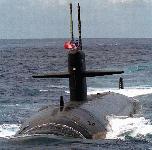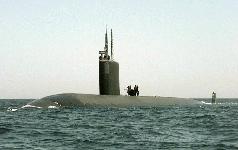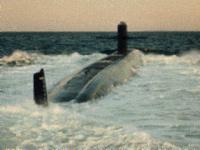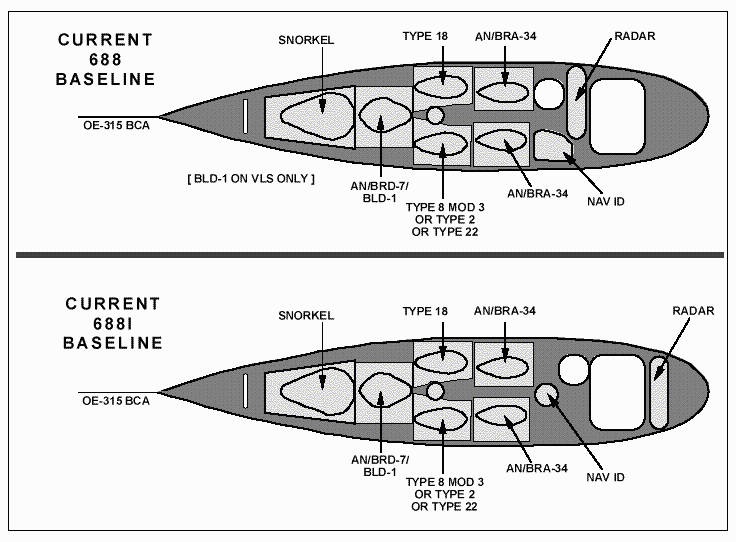



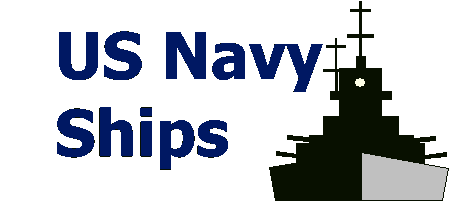
The LOS ANGELES class SSN specifically included ASW against Soviet submarines trying to sink the US carrier and ASUW against capital ships in the Soviet surface action group [SAG]. The LOS ANGELES class SSN was designed almost exclusively for Carrier Battlegroup escort; they were fast, quiet, and could launch Mk48 and ADCAP torpedoes, Harpoon Anti-Ship Missiles (no longer carried), and both land attack and anti-ship (no longer carried) Tomahawk cruise missiles. The new submarines showed another step improvement in quieting and an increase in operating speed to allow them to support the CVBG. Escort duties included conducting ASW sweeps hundreds of miles ahead of the CVBG and conducting attacks against the SAG.
Submarines of the LOS ANGELES Class are among the most advanced undersea vessels of their type in the world. While anti-submarine warfare is still their primary mission, the inherent characteristics of the submarine's stealth, mobility and endurance are used to meet the challenges of today's changing global geopolitical climate. Submarines are able to get on station quickly, stay for an extended period of time and carry out a variety of missions including the deployment of special forces, minelaying, and precision strike land attack.
These 360 foot, 6,900-ton ship are well equipped to accomplish these tasks. Faster than her predecessors and possessing highly accurate sensors, weapons control systems and central computer complexes, the LOS ANGELES Class is armed with sophisticated MK-48 Advanced Capability anti-submarine/ship torpedoes, Tomahawk land attack cruise missiles, and mines.These submarines were built in three successive variants:
The submarines are outfitted with a wide variety of antennas, transmitters and receivers necessary to support accomplishment of their assigned tasks. Interior communication is possible on a wide range of circuits and sound powered phones which do not require electrical power and are reliable in battle situations. Various alarm and indicating circuits enable the Officer of the Deck and the Engineering Officer of the Watch to continuously monitor critical parameters and equipment located throughout the ship.
The nuclear power plant gives these boats the ability to remain deployed and submerged for extended periods of time. To take advantage of this, the ship is outfitted with auxiliary equipment to provide for the needs of the crew. Atmosphere control equipment replenishes oxygen used by the crew, and removes carbon dioxide and other atmosphere contaminants. The ship is equipped with two distilling plants which convert salt water to fresh water for drinking, washing and the propulsion plant. Sustained operation of the complex equipment and machinery on the ship requires the support of repair parts carried on board. The ship carries enough food to feed a crew of over one hundred for as long as 90 days.

Los Angeles class submarines are divided into two watertight compartments. The forward compartment houses all the living spaces, weapons systems, control centers, and sonar/fire control computers. The after compartment houses the nuclear reactor and the ship's propulsion equipment.
1. Engine Room. The engine room houses all the propulsion machinery, as well as the Ship's Service Turbine Generators that supply the ship's electricity, and the evaporator, which distills water for the propulsion plant and other shipboard use.
2. Control Room/Attack Center. Located in the upper level of the forward compartment is the control room--the heart of the ship. The Officer of the Deck stands his watch here, controlling all activities on board. In control, the ship's location is continually determined and plotted, the course and depth are controlled, and all sonar contacts are tracked. The control room also functions as the attack center, where all of the ship's weapon systems are controlled from.. The sail helps to add stability to the submerged vessel. Additionally it houses all of the periscopes and antennae. In the forward top portion of the sail is the bridge. When the ship is on the surface, the Officer of the Deck will shift his watch to the bridge. Here he has clear view of all the surrounding waters, in addition to getting a breath of fresh air and seeing the welcome sun.
4. Mess Decks, Berthing, and Wardroom. The middle level of the forward compartment is dedicated to the crew's living spaces. Here is found the mess decks and galley which, when underway, serve four meals a day, one every six hours (allowing for all watchstanders to get a hot meal). Also here are the berthing spaces. Here is the only personal space that a crewman gets--his bed (known as a "rack". These racks are stacked three tall throughout the berthing spaces and have only a curtain to close them off from the rest of the boat. With this as the only private area on board, it is not uncommon to find pictures of family and friends put up on the wall in a rack along with personal cassette and CD players for entertainment. The wardroom> is the officers own room. Here is a big table around which the officers eat, train, and work
5. Torpedo Room. The lower level of the forward compartment is the Torpedo Room. This room stores the ship's weapons which include Mk48 ADCAP torpedoes, Tomahawk cruise missiles, and mines. The torpedo room houses the handling equipment and access to the ship's four torpedo tubes. Weapons are moved from their stowage positions, loaded into the tubes, and readied for launch all in this room by the ship's Torpedomen. The torpedo room also houses controls for the vertical launch tubes which add 12 more Tomahawk cruise missiles to the ship's load.
6. Sonar Sphere. Housed in the very forward end of the submarine is the sonar sphere. This is an array of over 1,000 hydrophones which makes up part of the advanced BQQ-5E sonar suite. Out in front of the ship, positions the sphere as far as possible from the ship's own noise, thereby giving it the best listening conditions.
SSN 688-class submarines, which will comprise 68% of the attack submarine force in 2015, must be modernized to ensure that they remain effective against increasingly sophisticated undersea adversaries. The use of COTS and open systems architecture (OSA) will enable rapid (annual) updates to both software and hardware, and the use of COTS-based processors means that sonar system computing power can grow at the same rate as commercial technology.The creation of the Acoustic Rapid COTS Insertion (A-RCI) program was based on a detailed review of the U.S. acoustic advantage compared to foreign nuclear and diesel electric submarines. This program is the centerpiece of the Los Angeles (SSN 688)-class modernization effort. SSN 688 class submarines, which will comprise 68% of the attack submarine force in 2015, must be modernized to ensure that they remain effective when operating against increasingly sophisticated undersea adversaries. The use of COTS and Open Systems Architecture (OSA) will enable rapid (annual) updates to both software and hardware, and the use of COTS-based processors means that sonar system computing power can grow at the same rate as the commercial world.
A-RCI is a four phased transformation of existing sonar systems (AN/BSY-1, AN/BQQ-5, or AN/BQQ-6) to a more capable and flexible COTS/OSA-based system. It also will provide the submarine force with a common sonar system. The process is designed to minimize the impact of fire-control and sonar system upgrades on a ship's operational schedule, and will be accomplished without the need for major shipyard availabilities. Phase I, which commenced in November 1997, will enhance towed-array processing. Phase II will provide additional towed- and hull-array software upgrades. Phase III will upgrade the spherical array, and Phase IV will upgrade the high-frequency sonar system on SSN 688I-class submarines. Each phase will install improved processing and control and display workstations. The current installation plan completes all SSNs through Phase III by FY03.Between 1998 and 2001 the US will retire 11 Los Angeles class submarines that have an average of 13 years left on their 30-year service lives. SSN-688 class submarines could operate for much longer than 30 years; one of the shipbuilders stated that 10 to 20 years of additional service would not be unreasonable. Past Navy actions indicate that extending a submarine's service life may be feasible. After a 5-year study was completed on the SSN-637 class submarine--the predecessor of the SSN-688 class--the design life was extended from 20 years to 30 years, with a possible extension to 33 years on a case-by-case basis. The 18 SSN-688 class submarines that will be refueled at their mid-life could make good candidates for a service life extension because they could operate for nearly 30 years after the refueling. After these submarines serve for 30 years, they could undergo a 2-year overhaul and serve for one more 10-year operating cycle, for a total service life of 42 years. The cost for the additional overhaul of SSN-688 class submarines would be about $406 million per boat.
Eight older Los Angeles-class submarines, without a vertical launch system, could be refueled at a cost of $210 million more than it would cost to inactivate them.The JCS Submarine Force Structure Study, completed in November 1999, concluded that the optimal force structure would be 68 attack submarines by 2015 and 76 by 2025, with the minimum being at least 55 by 2015 and 62 by 2025. The first would be to refuel some Los Angeles-class submarines previously scheduled to be decommissioned.
Specifications | |
| Builders | Newport News Shipbuilding Co. General Dynamics Electric Boat Division. |
| Power Plant | One S6G reactor one shaft at 35,000 shp Improved Performance Machinery Program Phase I [on 688 Improved] |
| Length | 360 feet (109.73 meters) |
| Beam | 33 feet (10 meters) |
| Displacement | 6,927 tons (6210 metric tons) submerged |
| Speed | Official: 20+ knots (23+ miles per hour, 36.8 +kph) Actual: 30-32 knots maximum submerged speed |
| Operating Depth |
official: "greater than 800 feet" Actual: 950 feet [300 meters] test depth Actual: 1475 feet [450 meters] collapse depth |
| Hull | HY-80 Steel |
| Crew | 13 Officers, 116 Enlisted
Departments
|
| Armament |
Harpoon and Tomahawk ASM/LAM missiles from VLS tubes MK-48 torpedoes from four 533-mm torpedo tubes (Seawolf has 8) |
| Combat Systems |
AN/BPS-5 surface search radar AN/BPS-15 A/16 navigation and fire control radar TB-16D passive towed sonar arrays TB-23 passive "thin line" towed array AN/BQG-5D wide aperture flank array AN/BQQ-5D/E low frequency spherical sonar array AN/BQS-15 close range active sonar (for ice detection); MIDAS Mine and Ice Detection Avoidance System SADS-TG active detection sonar Type 2 attack periscope (port) Type 18 search periscope (starboard) AN/BSY-1 (primary computer); UYK-7; UYK-43; UYK-44 WLR-9 Acoustic Intercept Receiver ESM |
| Unit Cost | $900 million [1990 prices] |
| Unit Operating Cost Annual Average | ~$21,000,000 [source: [FY1996 VAMOSC] |
Ships | ||||||
| Name | Number | Builder | Homeport | Ordered | Commissioned | Decommissioned |
| Los Angeles | SSN 688 | Newport News | Pearl Harbor | 08 Jan 1971 | 13 Nov 1976 | |
| Baton Rouge | SSN-689 | Newport News | Norfolk | 08 Jan 1971 | 25 Jun 1977 | 13 Jan 1995 |
| Philadelphia | SSN 690 | Electric Boat | Groton | 08 Jan 1971 | 25 Jun 1977 | |
| Memphis | SSN 691 | Newport News | Groton | 04 Feb 1971 | 17 Dec 1977 | |
| Omaha | SSN-692 | Electric Boat | Pearl Harbor | 31 Jan 1971 | 11 Mar 1978 | 05 Oct 1995 |
| Cincinnati | SSN-693 | Newport News | Norfolk | 04 Feb 1971 | 10 Jun 1978 | 29 Jul 1996 |
| Groton | SSN-694 | Electric Boat | Groton | 31 Jan 1971 | 08 Jul 1978 | 07 Nov 1997 |
| Birmingham | SSN-695 | Newport News | Pearl Harbor | 24 Jan 1972 | 16 Dec 1978 | 22 Dec 1997 |
| New York City | SSN-696 | Electric Boat | Pearl Harbor | 24 Jan 1972 | 03 Mar 1979 | 30 Apr 1997 |
| Indianapolis | SSN 697 | Electric Boat | Pearl Harbor | 24 Jan 1972 | 05 Jan 1980 | 17 Feb 1998 |
| Bremerton | SSN 698 | Electric Boat | Pearl Harbor | 24 Jan 1972 | 28 Mar 1981 | ~2001 |
| Jacksonville | SSN 699 | Electric Boat | Norfolk | 24 Jan 1972 | 16 May 1981 | ~2001 |
| Dallas | SSN 700 | Electric Boat | Groton | 31 Jan 1973 | 26 Jun 1981 | |
| La Jolla | SSN 701 | Electric Boat | San Diego | 10 Dec 1973 | 30 Sep 1981 | |
| Phoenix | SSN-702 | Electric Boat | Norfolk | 31 Oct 1973 | 12 Dec 1981 | 29 Jul 1998 |
| Boston | SSN 703 | Electric Boat | Groton | 10 Dec 1973 | 30 Jan 1982 | 18 Jan 1999 |
| Baltimore | SSN 704 | Electric Boat | 31 Oct 1973 | 24 Jul 1982 | 10 Jul 1998 | |
| City Of Corpus Christi | SSN 705 | Electric Boat | Groton | 31 Oct 1973 | 08 Jan 1983 | |
| Albuquerque | SSN 706 | Electric Boat | Groton | 31 Oct 1973 | 21 May 1983 | |
| Portsmouth | SSN 707 | Electric Boat | San Diego | 10 Dec 1973 | 01 Oct 1983 | |
| Minneapolis-St. Paul | SSN 708 | Electric Boat | Norfolk | 31 Oct 1973 | 10 Mar 1984 | |
| Hyman G. Rickover | SSN 709 | Electric Boat | Norfolk | 10 Dec 1973 | 21 Jul 1984 | |
| Augusta | SSN 710 | Electric Boat | Groton | 31 Oct 1973 | 19 Jan 1985 | ~2008 |
| San Francisco | SSN 711 | Newport News | Pearl Harbor | 01 Aug 1975 | 21 Apr 1984 | |
| Atlanta | SSN 712 | Newport News | Norfolk | 01 Aug 1975 | 06 Mar 1982 | 22 Jan 1999 |
| Houston | SSN 713 | Newport News | San Diego | 01 Aug 1975 | 25 Sep 1982 | ~2000 |
| Norfolk | SSN 714 | Newport News | Norfolk | 20 Feb 1976 | 21 May 1983 | ~2001 |
| Buffalo | SSN 715 | Newport News | Pearl Harbor | 23 Feb 1976 | 05 Nov 1983 | |
| Salt Lake City | SSN 716 | Newport News | San Diego | 15 Sep 1977 | 12 May 1984 | ~2005 |
| Olympia | SSN 717 | Newport News | Pearl Harbor | 15 Sep 1977 | 17 Nov 1984 | ~2006 |
| Honolulu | SSN 718 | Newport News | Pearl Harbor | 15 Sep 1977 | 06 Jul 1985 | ~2007 |
| Providence | SSN 719 | Electric Boat | Groton | 16 Apr 1977 | 27 Jul 1985 | |
| Pittsburgh | SSN 720 | Electric Boat | Groton | 16 Apr 1977 | 23 Nov 1985 | |
| Chicago | SSN 721 | Newport News | Pearl Harbor | 13 Aug 1981 | 27 Oct 1986 | |
| Key West | SSN 722 | Newport News | Pearl Harbor | 13 Aug 1981 | 12 Sep 1987 | |
| Oklahoma City | SSN 723 | Newport News | Norfolk | 13 Aug 1981 | 09 Jul 1988 | |
| Louisville | SSN 724 | Electric Boat | Pearl Harbor | 11 Feb 1981 | 08 Nov 1986 | |
| Helena | SSN 725 | Electric Boat | Pearl Harbor | 19 Apr 1982 | 11 Jul 1987 | |
| Newport News | SSN 750 | Newport News | Norfolk | 19 Apr 1982 | 03 Jun 1989 | |
| IMPROVED 688 - 688I | ||||||
| San Juan | SSN 751 | Electric Boat | Groton | 30 Nov 1982 | 06 Aug 1988 | |
| Pasadena | SSN 752 | Electric Boat | Pearl Harbor | 30 Nov 1982 | 11 Feb 1989 | |
| Albany | SSN 753 | Newport News | Norfolk | 20 Nov 1983 | 07 Apr 1990 | |
| Topeka | SSN 754 | Electric Boat | Pearl Harbor | 28 Nov 1983 | 21 Oct 1989 | |
| Miami | SSN 755 | Electric Boat | Groton | 28 Nov 1983 | 30 Jun 1990 | |
| Scranton | SSN 756 | Newport News | Norfolk | 26 Nov 1984 | 26 Jan 1991 | |
| Alexandria | SSN 757 | Electric Boat | Groton | 26 Nov 1984 | 29 Jun 1991 | |
| Asheville | SSN 758 | Newport News | Pearl Harbor | 26 Nov 1984 | 28 Sep 1991 | |
| Jefferson City | SSN 759 | Newport News | San Diego | 26 Nov 1984 | 29 Feb 1992 | |
| Annapolis | SSN 760 | Electric Boat | Groton | 21 Mar 1986 | 11 Apr 1992 | |
| Springfield | SSN 761 | Electric Boat | Groton | 21 Mar 1986 | 09 Jan 1993 | |
| Columbus | SSN 762 | Electric Boat | Pearl Harbor | 21 Mar 1986 | 24 Jul 1993 | |
| Santa Fe | SSN 763 | Electric Boat | Pearl Harbor | 21 Mar 1986 | 11 Dec 1993 | |
| Boise | SSN 764 | Newport News | Norfolk | 06 Feb 1987 | 07 Nov 1992 | |
| Montpelier | SSN 765 | Newport News | Norfolk | 06 Feb 1987 | 13 Mar 1993 | |
| Charlotte | SSN 766 | Newport News | Pearl Harbor | 06 Feb 1987 | 16 Sep 1994 | |
| Hampton | SSN 767 | Newport News | Norfolk | 06 Feb 1987 | 16 Nov 1993 | |
| Hartford | SSN 768 | Electric Boat | Groton | 30 Jun 1988 | 10 Dec 1994 | |
| Toledo | SSN 769 | Newport News | Groton | 10 Jun 1988 | 24 Feb 1995 | |
| Tucson | SSN 770 | Newport News | Pearl Harbor | 10 Jun 1988 | 18 Aug 1995 | |
| Columbia | SSN 771 | Electric Boat | Pearl Harbor | 14 Dec 1988 | 09 Oct 1995 | |
| Greenville | SSN 772 | Newport News | Pearl Harbor | 14 Dec 1988 | 16 Feb 1996 | |
| Cheyenne | SSN 773 | Newport News | Norfolk | 28 Nov 1989 | 13 Sep 1996 | |

